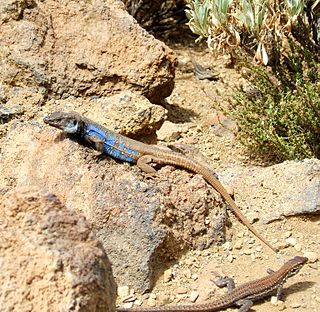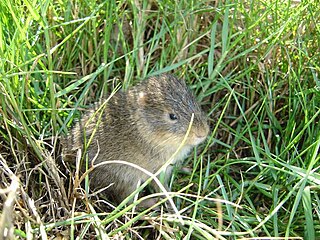
The genus Gallotia are the lacertids of the Canary Islands. This genus consists of a group that has been evolving there ever since the first islands emerged from the sea over 20 million years ago. The endemic species and subspecies of this group have a number of characteristics that make them quite special within their family (Lacertidae); their only close relatives are the sandrunner lizards (Psammodromus) of the western Mediterranean region. Gallotia are characteristic for eating significant quantities of plants, and several lineages are often presented as classic examples for insular gigantism. However, a find of an even larger Gallotia species from the early Miocene of mainland Europe casts doubt on this assumption. Instead the ancestor of all modern Gallotia species of the Canary islands was probably already very large but carnivorous.

The intermediate egret, median egret, smaller egret, or yellow-billed egret is a medium-sized heron. Some taxonomists put the species in the genus Egretta or Mesophoyx. It is a resident breeder from east Africa across the Indian subcontinent to Southeast Asia and Australia.

The long-tailed paradigalla is a large, approximately 37 cm long, black bird-of-paradise with long and pointed tail. One of the most plain members in the family Paradisaeidae, its only adornment is the colorful facial wattles of yellow, red and sky-blue near base of the bill. Both sexes are similar in appearance, however the female is slightly duller and smaller.

The lesser siren is a species of aquatic salamander native to the eastern United States and northern Mexico. They are referred to by numerous common names, including two-legged eel, dwarf siren, and mud eel. The specific epithet intermedia denotes their intermediate size, between the greater siren, Siren lacertina, and the dwarf sirens, Pseudobranchus species.

Santa Catarina's guinea pig or Moleques do Sul cavy is a rare guinea pig species of southeastern South America.
The intermediate slit-faced bat is a species of slit-faced bat living in forest and savanna regions of west and central Africa. It is easily confused with Nycteris arge and Nycteris nana. It is broadly distributed, but is classified as near-threatened because of the threat of predicted habitat loss. It is much more restricted to true rainforest than is N. arge.

The small woolly bat is a species of vesper bat in the family Vespertilionidae. It is found only in Malaysia and is little known. It is only slightly larger than the Kitti's hog-nosed bat, one of the smallest mammals in the world. The small woolly bat weighs 2.5 to 4 g.

The white-vented plumeleteer is a species of hummingbird in the "emeralds", tribe Trochilini of subfamily Trochilinae. It is found in Colombia, Ecuador, Panama, Peru, and Venezuela.

The Italian tree frog is a species of frog in the family Hylidae, found in Italy, Slovenia, Switzerland, and possibly San Marino. Its natural habitats are temperate forests, rivers, intermittent rivers, freshwater marshes, intermittent freshwater marshes, arable land, and urban areas. It is threatened by habitat loss.

Brachytarsophrys intermedia is a species of frog in the family Megophryidae. It is found in the Central Highlands of southern Vietnam, Laos, and possibly Cambodia. This species might be a synonym of Brachytarsophrys carinense.

The grey seedeater is a species of bird in the family Thraupidae. It is found in Brazil, Colombia, Ecuador, Guyana, Trinidad and Tobago, and Venezuela. Its natural habitats are subtropical or tropical seasonally wet or flooded lowland grassland and heavily degraded former forest.
Tristramella intermedia is an extinct species of fish in the family Cichlidae. It was endemic to Lake Hula in northern Israel. This taxon was considered to be a subspecies of T. simonis in FishBase and considered a synonym of T. simonis by Catalog of Fishes, a view with which FishBase now concurs. This species reached a length of 22.9 centimetres (9.0 in) TL.

Theliderma intermedia, the Cumberland monkeyface pearly mussel or Cumberland monkeyface, is a species of freshwater mussel in the family Unionidae, the river mussels. This aquatic bivalve mollusk is native to Tennessee and Virginia in the United States. Historically widespread in the upper Tennessee River system, it populations have been reduced by habitat destruction and pollution. It now only occurs in two tributaries: the Duck and Powell Rivers. It is a federally listed endangered species.

Lestrolepis is a genus of barracudina.

Yucca flaccida, commonly called Adam's needle or weak-leaf yucca, is a species of flowering plant in the asparagus family (Asparagaceae). It is native to south-central and southeastern North America, from the lower Great Plains eastward to the Atlantic seaboard in Virginia, south through Florida and the Gulf states. Its natural habitat is in sandy open woodlands and fields. It is not considered to be threatened by the IUCN.
Ulmus × intermediaElowsky is a natural hybrid elm occurring across Nebraska and several other Midwestern states, derived from the crossing of Ulmus rubra and Ulmus pumila. As Red Elm U. rubra is far less fertile, and highly susceptible to Dutch elm disease (:DED), it could eventually be hybridized out of existence by U. × intermedia. The hybrid was first reported from the wild in the Chicago region in 1950 and was provisionally named U. × nothaWilhelm & Ware in 1994.
Lestrolepis luetkeni is a species of fish in the family Paralepididae.
Lestrolepis japonica is a species of fish in the family Paralepididae.
Sphyraena intermedia commonly known as the intermediate barracuda is a species of barracuda that was only recently discovered in the Gulf of Taranto in the south of Italy. Very similar to the other four species of Barracuda that inhabit the Mediterranean Sea particularly the European barracuda and yellowmouth barracuda. They are distinguished by being intermediate in size between European and Yellowmouth barracudas as well as a few other differences such as different amounts of scales and certain body measurements.














